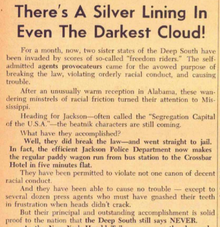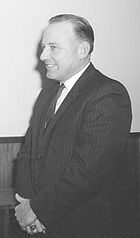- White Citizens' Council
-
White Citizens' Council 
A logo of the White Citizens' CouncilAbbreviation WCC Successor Council of Conservative Citizens Formation July 11, 1954 Membership 60,000 (1955) Founder Robert Patterson The White Citizens' Council (WCC) was an American white supremacist organization formed on July 11, 1954.[1] After 1956, it was known as the Citizens' Councils of America. With about 60,000 members,[2] mostly in the South, the group was well known for its opposition to racial integration. By the 1970s, the influence of the WCC had waned considerably. The successor organization to the White Citizens' Council is the Council of Conservative Citizens, founded in 1985.[2]
Contents
History
Some sources claim that the White Citizens' Council originated in Greenwood, Mississippi following the 1954-1955 Brown vs. Board of Education decisions,[3] while others claim that it originated in Indianola, Mississippi.[4] The leader was Robert B. Patterson [5] of Indianola.[1] Patterson was a plantation manager and the former captain of the Mississippi State University football team. Additional chapters soon appeared in other communities.
The formation of the WCC was partly a response to the assertive activities of the Regional Council of Negro Leadership (RCNL), a grassroots civil organization organized by T. R. M. Howard of the all-black town Mound Bayou, Mississippi in 1951. Mound Bayou was only forty miles from Indianola, Mississippi. Although as an adult Patterson was opposed to such groups, in boyhood in Clarksdale, Mississippi, Patterson was a friend of Aaron Henry, an official in the RCNL and the future head of the Mississippi NAACP.[6]
Within a few months, the WCC had attracted members and new chapters developed beyond Mississippi into the rest of the Deep South. It often had the support of the leading citizens of many communities, including business, civic and sometimes religious leaders.
Economic retaliation and violence
Unlike the Ku Klux Klan, the WCC met openly and was seen as "pursuing the agenda of the Klan with the demeanor of the Rotary."[7] Also unlike the Klan, the group eschewed the use of violence,[1] instead using economic and political tactics.[3] However, Charles Payne notes that "Despite the official disclaimers, violence often followed in the wake of Council intimidation campaigns."[7] Occasionally some Councils would incite to violence explicitly. For instance, in Montgomery, Alabama, during the Montgomery Bus Boycott, a mimeographed flyer was distributed at a Council meeting in the Garrett Coliseum which read, in part:
When in the course of human events, it becomes necessary to abolish the Negro race, proper methods should be used. Among these are guns, bows and arrows, sling shots and knives. We hold these truths to be self-evident that all whites are created equal with certain rights; among these are life, liberty and the pursuit of dead niggers.[8]
African Americans who were seen as being too supportive of desegregation, voting rights, or even of belonging to the NAACP, found themselves subjected to extreme economic pressure by the Citizens' Councils, including having their mortgages called in, loans denied them, and their businesses subjected to boycotts.[9] In some cities, the Councils published lists of names of NAACP supporters and signers of antisegregation petitions in local newspapers in order to encourage economic retaliation.[10] For instance, in Yazoo City, Mississippi in 1955, the Citizens' Council arranged for the names of 53 signers of a petition for school integration to appear in a local paper, and soon afterwards, the petitioners lost their jobs and had their credit cut off.[11] As Charles Payne puts it, the Councils operated by "unleashing a wave of economic reprisals against anyone, Black or white, seen as a threat to the status quo."[7] Medgar Evers' first work for the NAACP on a national level involved interviewing Mississippians who had been intimidated by the Citizens' Councils and preparing affadavits for use as evidence against the Councils if necessary.[12]
Political influence
Many state and local politicians were members of the Councils, which at least in some states, gave them immense influence over state legislatures. In Mississippi, the State Sovereignty Commission funded the Citizens' Councils, in some years providing as much as $50,000. This state agency also shared information on integration activists with the Councils.[13] Dr. M. Ney Williams was both a director of the Citizens' Council and an advisor to governor Ross Barnett of Mississippi.[14] Barnett himself was a member of the Council, as was Jackson, Mississippi mayor Allen C. Thompson.[15] In 1955, in the midst of the bus boycott, all three members of the Montgomery city commission announced on television that they had joined the Citizens' Council.[16]
Numan Bartley states that "In Louisiana the Citizens' Council organization began as (and to a large extent remained) a projection of the Joint Legislative Committee to Maintain Segregation."[17] In Louisiana, leaders of the original Citizens' Council included State Senator and gubernatorial candidate William Rainach, future U.S. Representative Joe D. Waggonner, Jr., publisher Ned Touchstone, and Judge Leander Perez, considered the political boss of Plaquemines and St. Bernard parishes south of New Orleans.[18] On July 16, 1956, "under pressure from the White Citizens Councils,"[19] the Louisiana State Legislature passed an amendment to the Louisiana Constitution mandating racial segregation in nearly every aspect of public life. The bill was signed into law by governor Earl Long on 16 July 1956 and went into effect on 15 October, 1956. The amendment read, in part:
An Act to prohibit all interracial dancing, social functions, entertainments, athletic training, games, sports, or contests and other such activities; to provide for separate seating and other facilities for white and negroes [lower case in original]... That all persons, firms, and corporations are prohibited from sponsoring, arranging, participating in or permitting on premises under their control... such activities involving personal and social contact in which the participants are members of the white and negro races... That white persons are prohibited from sitting in or using any part of seating arrangements and sanitary or other facilities set apart for members of the negro race. That negro persons are prohibited from sitting in or using any part of seating arrangements and sanitary or other facilities set apart for white persons.[19]
School segregation and the demise of the councils
As school desegregation increased, in some communities "council schools," sponsored by the WCC, were set up for white children.[20] Many of these "segregation academies" still exist today.
By the 1970s, as white Southerners' attitudes toward desegregation began to change, the influence of the WCCs began to wane. A few such groups still exist, including the Council of Conservative Citizens, founded by former White Citizens' Council members.[2]
See also
- American Civil Rights Movement (1896–1954)
- American Civil Rights Movement (1955–1968)
- Timeline of the American Civil Rights Movement
References
- ^ a b c "July 11, 1954". University of Southern Mississippi. http://www.usm.edu/crdp/html/cd/citizens.htm. Retrieved 8 September 2011.
- ^ a b c "Council of Conservative Citizens". Anti-Defamation League. http://www.adl.org/learn/ext_us/CCCitizens.asp?xpicked. Retrieved 8 September 2011.
- ^ a b "White Citizens' Councils aimed to maintain 'Southern way of life'". The Jackson Sun. http://orig.jacksonsun.com/civilrights/sec2_citizencouncil.shtml. Retrieved 8 September 2011.
- ^ Roberts, Gene and Hank Klibanoff (2006). The Race Beat: The Press, the Civil Rights Struggle, and the Awakening of a Nation. New York: Alfred A. Knopf. p. 66. ISBN 0679403817.
- ^ Cobb, James C. (23 December 2010). "The Real Story of the White Citizens' Council". History News Network. http://hnn.us/articles/134814.html. Retrieved 9 September 2011.
- ^ Beito, David T.; Beito, Linda Royster (8 April 2009). Black maverick: T.R.M. Howard's fight for civil rights and economic power. University of Illinois Press. pp. 95–97. ISBN 978-0-252-03420-6. http://books.google.com/books?id=dS4eA77qau0C. Retrieved 8 September 2011.
- ^ a b c Payne, Charles M. (16 March 2007). I've got the light of freedom: the organizing tradition and the Mississippi freedom struggle. University of California Press. pp. 34–35. ISBN 978-0-520-25176-2. http://books.google.com/books?id=4eh_iGj2bzsC. Retrieved 7 September 2011.
- ^ Poston, Ted (15 & 19 June 1956). "The Negroes of Montgomery". New York Post. reprinted in Carson, Clayborne; Garrow, David J.; Kovach, Bill (2003). Reporting Civil Rights: American journalism, 1941-1963. Library of America. pp. 266-279. http://books.google.com/books?id=9j8OAQAAMAAJ. Retrieved 14 September 2011.
- ^ Dittmer, John (1 May 1995). Local people: the struggle for civil rights in Mississippi. University of Illinois Press. pp. 46-48. ISBN 978-0-252-06507-1. http://books.google.com/books?id=-k9Wyp87Z7cC. Retrieved 7 September 2011.
- ^ McMillen, Neil R. (1971). The Citizen's Council: Organized Resistance to the Second Reconstruction, 1954-1964. Urbana: University of Illinois Press. p. 211. ISBN 025200177X.
- ^ Wakefield, Dan (22 October 1955). "Respectable Racism". The Nation. reprinted in Carson, Clayborne; Garrow, David J.; Kovach, Bill (2003). Reporting Civil Rights: American journalism, 1941-1963. Library of America. pp. 222-227. http://books.google.com/books?id=9j8OAQAAMAAJ. Retrieved 13 September 2011.
- ^ Vollers, Maryanne (April 1995). Ghosts of Mississippi: the murder of Medgar Evers, the trials of Byron de la Beckwith, and the haunting of the new South. Little, Brown. pp. 57–58. ISBN 978-0-316-91485-7. http://books.google.com/books?id=Zix1QgAACAAJ. Retrieved 9 September 2011.
- ^ Vollers, Maryanne (April 1995). Ghosts of Mississippi: the murder of Medgar Evers, the trials of Byron de la Beckwith, and the haunting of the new South. Little, Brown. pp. 75. ISBN 978-0-316-91485-7. http://books.google.com/books?id=Zix1QgAACAAJ. Retrieved 9 September 2011.
- ^ Leonard, George B.; Harris, T. George; Wren, Christopher S. (31 December 1962). "How a Secret Deal Prevented a Massacre at Ole Miss". Look. Reprinted in Carson, Clayborne; Garrow, David J.; Kovach, Bill (2003). Reporting Civil Rights: American journalism, 1941-1963. Library of America. pp. 671-701. http://books.google.com/books?id=9j8OAQAAMAAJ. Retrieved 14 September 2011.
- ^ Sitton, Claude (13 June 1963). "N.A.A.C.P. Leader Slain in Jackson; Protests Mount". New York Times. reprinted in Carson, Clayborne; Garrow, David J.; Kovach, Bill (2003). Reporting Civil Rights: American journalism, 1941-1963. Library of America. pp. 831-835. http://books.google.com/books?id=9j8OAQAAMAAJ. Retrieved 14 September 2011.
- ^ Reddick, L.D. (Winter 1956). "The Bus Boycott in Montgomery". Dissent. reprinted in Carson, Clayborne; Garrow, David J.; Kovach, Bill (2003). Reporting Civil Rights: American journalism, 1941-1963. Library of America. pp. 252-265. http://books.google.com/books?id=9j8OAQAAMAAJ. Retrieved 14 September 2011.
- ^ Bartley, Numan V. (1999). The rise of massive resistance: race and politics in the South during the 1950's. LSU Press. p. 86ff. ISBN 978-0-8071-2419-2. http://books.google.com/books?id=tOy6PLcuey4C. Retrieved 7 September 2011.
- ^ McMillen, Neil R. (1971). "Chapter IV Louisiana: And Catholics Too". The Citizen's Council: Organized Resistance to the Second Reconstruction, 1954-1964. Urbana: University of Illinois Press. pp. 59-72. ISBN 025200177X.
- ^ a b Bagdikian, Ben (20 & 22 October, 1957). "You Can't Legislate Human Relations". The Providence Journal and Evening Bulletin. reprinted in Carson, Clayborne; Garrow, David J.; Kovach, Bill (2003). Reporting Civil Rights: American journalism, 1941-1963. Library of America. pp. 390-395. http://books.google.com/books?id=9j8OAQAAMAAJ. Retrieved 15 September 2011.
- ^ McMillen, Neil R. (1971). The Citizen's Council: Organized Resistance to the Second Reconstruction, 1954-1964. Urbana: University of Illinois Press. p. 301. ISBN 025200177X.
Further reading
- McMillen, Neil R. (1 October 1994). The Citizens' Council: Organized Resistance to the Second Reconstruction, 1954-64. University of Illinois Press. ISBN 978-0-252-06441-8. http://books.google.com/books?id=5djXaCZwXfQC. Retrieved 6 September 2011.
External links
- The Citizens' Council; digitized copies of the Citizen Council's newspaper, 1955–1961. Originally a publication of the Mississippi Citizens' Council, it became the official paper of the Citizens' Councils of America in October 1956.
- Available in PDF from Internet Archive.
- Civil Rights Documentation Project page
- Dr. John Dittmer on Governor Haley Barbour's Praise of White Citizens’ Councils - video report by Democracy Now!
- Schwerner, Chaney, and Goodman: The Struggle for Justice
Categories:- White Citizens' Council
- Organizations established in 1954
- Far-right politics in the United States
- White supremacist groups in the United States
- Council of Conservative Citizens
Wikimedia Foundation. 2010.


